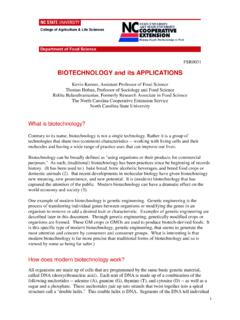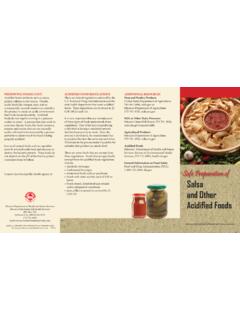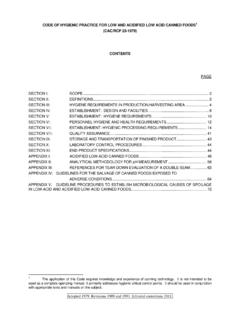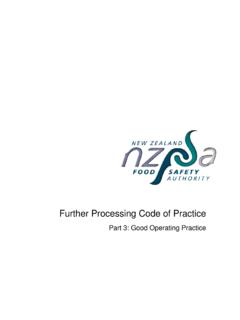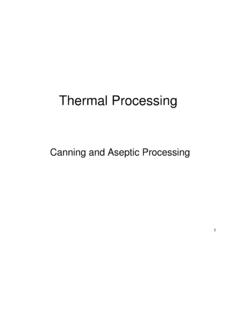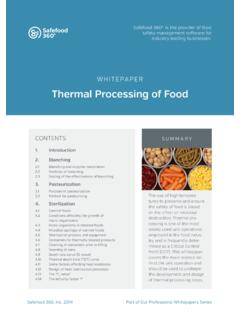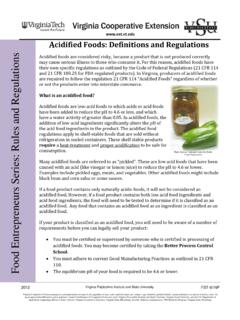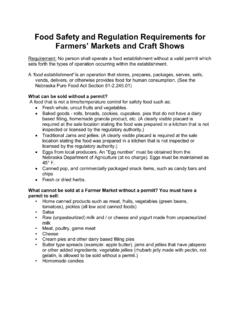Transcription of Department of Food Science Food Safety - FBNS
1 Department of food ScienceFood SafetyFSE 99-21_____Formulating Dressings, Sauces, and MarinadesJohn E. Rushing, , sauces, marinades and similar foodproducts depend on their acidity to prevent may consist of naturally occurring acid foodssuch as fruit juices or tomatoes, or they may beformulated by combining acid foods with other foodsto achieve the desired acidity. Some foods, such asvinegar and certain pickled vegetables, may havedeveloped acidity from microbial foods without adequate acidity may allow thegrowth of those micro- organisms which causefoodborne illness, government regulations addressthe manufacture of these products. Title 21 of theCode of Federal Regulations, Part 114 (21 CFR114)regulates acidified OF FOODS PRESERVED BYACIDSN aturally acid foods and fermented foods along withjams, jellies, preserves and certain dressings andsauces are exempted from the provisions of21 CFR114.
2 Generally, if a food is formulated frompredominantly acid foods it meets the exemptions. If,however the food contains a mixture of acid and lowacid foods, it falls under the provisions of AND pHFood scientists measure the acidity of a food based onits pH value. The pH scale ranges from 0 to 14 withph 7 being neutral. Any pH below pH 7 falls in theacidic range while those above pH 7 are considered tobe in the basic range. The lower the pH reading, themore acid the order to preserve foods with acidity, the regulationrequires the pH to be or below. At these levels,toxins formed by the deadly organism causingbotulism are refer to foods which have readings greater thanpH as low- acid foods.
3 Remember, low- acid foodshave high pH readings. Table 1 lists the pH of somerepresentative OF ACIDIFIED FOODSAcid foods depend on one or more food acids such ascitric, malic, or acetic acid to achieve stability. Mostacidified foods including dressings and sauces usevinegar (acetic acid ) to produce the desired is a familiar and effective source of food low- acid foods are used in formulations, it isimportant that they are properly acidified before theyhave a chance to spoil. They must reach equilibriumpH within an adequate time. The rate of up-take ofacid by low acid foods can be influenced by factorssuch as piece size or the presence of a waxy factors can often be overcome simply byreducing the piece size of the low acid food .
4 When oilis used in the formulation, the low acid componentsshould reach an equilibrium pH below prior toaddition of the foods possess a chemical property calledbuffering capacity, which allows them to resistchanges in pH. Greater amounts of acids must beadded to the foods at certain pH levels to continue toachieve reductions in pH. Buffering can also be aTable 1. Some pH Values of Green property to prevent changes of pH with minorvariations in added OF pHThe pH of a food is usually determined using a pHmeter. Electrodes from the meter are inserted intosolution to measure the pH electronically. A varietyof pH meters are available from scientific equipmentsuppliers.
5 Prices range from less than $100 to over$1,000 depending on the type and the features of of pH can also be obtainedcolorimetrically using pH test papers. These papers,available from scientific supply houses, can bepurchased for a few dollars. Regulations allowcolorimetric monitoring for foods with pH levelsbelow In order to have a built-in Safety factor, acid and acidified foods are normally formulated topH well below Most acidified foods have a pHbelow THE pH OF A FOODIn order to measure the pH of an acid food , the foodshould be liquid or prepared as a puree in a water may be added in order to thoroughlymix the components. Be sure to test asample representative of the whole.
6 Any oil layer mayneed to be removed by decanting in order to get ameasurement of the non-oil phase. In order tomeasure the equilibrium pH of a low acid food ,separate the low acid food portion from the acidifyingportion and prepare and measure the two SPOILAGEP roperly acidifying to pH or below will inhibit thegrowth and formation of toxins from the bacteriawhich cause botulism. Acidification cannot take theplace of proper sanitation and care in manufacturer must, therefore adhere to thehighest standards of cleanliness and protection ofproduct. These standards are covered under anotherregulation: 21 CFR110, often referred to as GoodManufacturing manufactured under proper conditions ofacidification and sanitation, a food product may stillbe spoiled by yeasts and molds.
7 In order to preventthis, acid and acidified foods are usually heated to180oF and packaged hot to kill yeast and mold sporeson the products and in the container and cap. Cool theproduct prior to placing in cardboard cases in order toavoid "stack burn".Figure 1. The pH ScaleSome products should not be heated. In these cases,increase the levels of acid or use chemicalpreservatives. Sodium benzoate and potassiumsorbate are often used for this purpose. They areusually used together to take advantage of theircombined REQUIREMENTSThe potential for improper formulation in themanufacturing of acidified foods has been determinedto be a public health hazard.
8 To reduce the likelihoodof foodborne illness, the acidified foods regulationrequires that a scheduled process for each product befiled with the FDA. The information filed must comefrom a recognized process authority who is qualifiedWhen measuring the pH of a prepared sample, besure to follow the instructions of the pH metermanufacturer carefully. In any case follow theseguidelines: Calibrate the pH meter using 2 buffers,usually pH 4 and pH 7. Make sure the temperature compensation isproperly set. Rinse the electrodes with distilled waterbetween readings. Pat dry with : DO NOT RUB THEELECTRODES WITH THE TISSUE ASTHIS WILL PRODUCE A STATICCHARGE AND RESULT IN IMPROPERREADINGS.
9 Stir samples while measuring. Record pHonly after readings stabilize. Products which have a high oil content mayclog the electrodes. Clean in alcohol or asrecommended by the manufacturer. Store the electrodes with tips submerged indistilled water or buffer as directed by acid Foods Basic Foods 14 Low acid Foods ( $ ) training and experience. In addition, personssupervising the manufacturing of acidified foods mustattend an approved school and must earn acertification as a supervisor for acidified foods. Theregulation also addresses other important aspects ofmanufacturing such as monitoring and record THE FOODR egulations dealing with the food label are extensiveand complicated.
10 Many are in a state of purchasing any labels, it would be wise toconsult with regulatory TO GET HELPThe North Carolina Cooperative Extension ServiceOffice In Your County Training and Certification Technical AssistanceThe North Carolina Department of Agriculture, food and Drug Protection Division Copies of Regulations Filing of ProcessesNorth Carolina Small Business TechnologyDevelopment Centers Business Start-up Advice Building a Business PlanREADING Acidified and Fermented Foods, RalphCostilow. Pickle Packers International, Inc., , IL 60174 canned Foods, FPI. food Processors Institute,1401 New York Ave.



